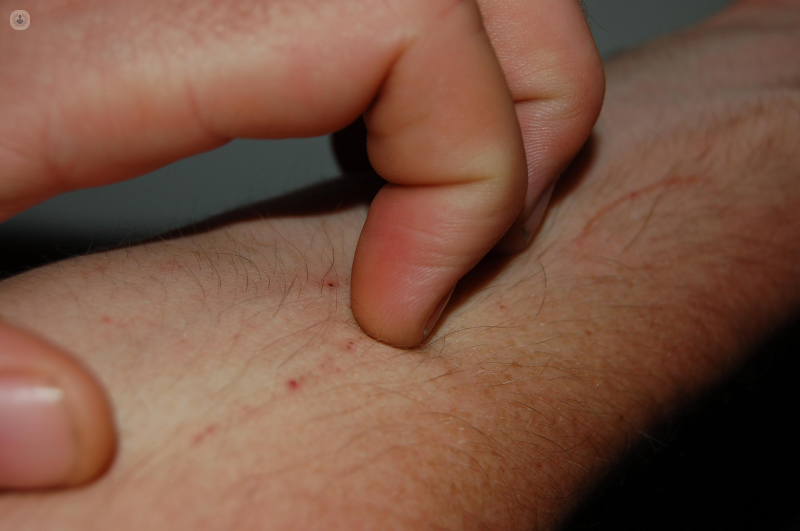
Introduction
Pruritus in chronic kidey disease (also known as uremic pruritus) is a common distressing symptom in end stage renal disease patients and in patients who are receiving dialysis. Uremic pruritus (UP) negatively affects quality of life of those patients, disturb sleeping and may be associated with depression and high risk of death. Several factors have been associated with uremic pruritus in dialysis patients:
- Lower dialysis adequacy.
- Use of low-flux dialyzers.
- Hepatitis C virus positivity.
- Higher serum CRP levels.
- Higher serum calcium and phosphorus levels.
- Smoking.
- Older age.
- Underlying depression.
- Elevated ferritin levels.
- Associated comorbidities
Treatment of UP is difficult and to answer the question of how to treat uremic pruritus, we have different treatment options which include optimizing dialysis parameters, phototherapy and systemic and topical drugs.
What causes uremic pruritus
The exact pathophysiology is poorly understood. but the followings have been suggested.
- Uremic toxins.
- Uncontrolled hyperparathyroidism.
- Microinflammation.
- Xerosis cutis.
- Metastatic microcalcifications caused by calcium and magnesium salts.
- Increased levels of IL-31, IL-6.
- Subclinical uremic neuropathy.
- Imbalance in opiate receptors activity.
- Immune dysregulation
General instructions
- Avoid skin dryness and keep it moist as possible.
- Bathing recommendations
- Bathing time should not exceed 20 min.
- Fragrance-free saops should be used.
- Limit use of soap to axillae and groin/perineum.
- Excessive bathing is not recommended.
- Use luke warm water not hot water.
- Moisturization
- Use a refrigerated emollient often helps considerably.
- Fragrance-free emollient BID to TID and especially after bathing.
- Baby oil BID to TID.
- Menthol 0.25%/camphor 0.25% in emollient BID to TID.
- Avoid all skin irritating products.
- Avoid wearing rough clothing, such as wool, over itchy areas.
- Avoid wool and other rough fabrics.
- Patients should avoid overbathing and overdrying their skin with soaps and cleansers.
- Patients should always have trimmed fingernails.
- Serum parathyroid hormone, calcium, and phosphorus levels should be assessed
- Treating the underlying iron deficiency may alleviate itch.
- Lowering PTH levels in patients with high PTH.
- Adjusting Dialysis parameters
- Use of high-flux dialyzers : it is more efficient in removing medium sized molecule including pruritogenic substances.
Topical treatment options for localised pruritus
- Topical calcineurin inhibitors
- Topical tacrolimus 0.1% ointment once daily for 4 weeks.
- Recurrence may occur upon discontinuation.
- Topical anesthetic
- Capsaicin ointment % or 0.075%, applied 2–4 times daily to affected areas.
- Pramoxine hydrochloride 1% lotion applied twice daily for 4 weeks.
- Topical counter-irritants
- 1% menthol in an aqueous base.`
- Cannabinoids
- Endocannabinoids containing N-acetylethanolamine and N-palmitoylethanolamine in the form of a topical cream applied twice daily for 3 weeks.
- Gamma linolenic acid ointment.
Medical treatment options of uremic pruritus
- Neuromodulators
- Gabapentin 100 mg once daily to 300 mg 3 times per week.
- Pregabalin 25- 50 mg 3 times weekly titrated up to 50 mg daily.
- Gabapentin and pregabalin require renal dosing adjustments.
- The dosing of gabapentin and pregabalin should not exceed a maximum dose of 300 or 100 mg daily.
- Signs of increased sedation and/or altered mental state should be monitored when prescribing these neuromodulators.
- Opioid-receptor modulation
- Nalfurafine hydrochloride
- Administered at an oral dose of 2.5- 5 μg per day.
- Common side events include insomnia, constipation, nasopharingitis and gastrointestinal symptoms including vomiting and diarrhea.
- Severe side events, include ventricular tachycardia and paraesthesia.
- Nalbuphine hydrochloride extended release tablets
- 30 mg QD to 240 mg BID over 15 days.
- The most common reported adverse drug effects included sedation, dizziness, nausea, and vomiting
- Difelikefalin
- The first FDA-approved medicine for uremic pruritus in the United States.
- Dosage : 0.5 mcg per kg IV bolus three times weekly into the venous port of the dialysis circuit immediately following dialysis.
- Side effects include diarrhea, vomiting, dizziness, paresthesia, hypoesthesia, somnolence.
- Nalfurafine hydrochloride
- Antidepressants
- Sertraline 25 mg daily if concomitant depression.
- Anithistamines
- doxepin 10 mg once or twice daily.
- Mirtazepine 15-30 mg/d.
- Others
- Thalidomide 100 mg/day.
- Montelukast 10 mg daily.
- Activated charcoal 6 g/day.
- Dupilumab.
- Nemolizumab (anti‐interleukin‐31).
- Ondansetron 8 mg orally or i.v. ( not effective)
Physical treatment options in chronic kidney disease-associated pruritus
- Phototherapy.
- Broad-band UVB and narrowband UVB phototherapy.
- Starting at three times per week and reducing to maintenance once or twice weekly can often control the pruritus.
- Increased risk of skin malignancy over a long-term period should be considered.
- Acupuncture and acupressure.
- May be used as complementary therapy in combination with standard treatment.
Points to remember ( How to treat uremic pruritus)
- In patients with end stage kidney disease complaining of itching, other causes of pruritus should be excluded.
- If uremic pruritus diagnosis has been made, optimizing dialysis should be done.
- Parathormone hormone and iron defeciency anemia should be assessed.
- Correct calcium and phosphate balance
- Patient skin should be kept moist all the time using enough emolients.
- both gabapentin 100 mg and pregabalin 25 mg improve pruritus in dialysis patients.
- BB UVB can be used for refractory cases.
- Kidney transplantation usually results in resolution of uraemic pruritus in most of patients..
References
Treatment of Uremic Pruritus: A Systematic Review
A review of the management of uremic pruritus: current perspectives and future directions
Itch and Ache on Dialysis: New Approaches to Manage Uremic Pruritus and Restless Legs
Was this helpful?
4 / 0
#Treatment options of uremic pruritus #uremic pruritus